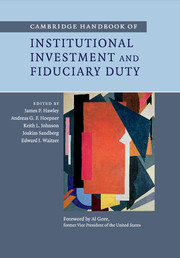Book contents
- Frontmatter
- Contents
- List of figures
- List of tables
- List of contributors
- Foreword
- 1 Introduction
- Part I Fiduciary duty: a global outlook
- Part II Fiduciary duty and the landscape of institutional investment
- 8 The philanthropic fiduciary: challenges for nonprofits, foundations and endowments
- 9 Paradigm lost: employment-based defined benefit plans and the current understanding of fiduciary duty
- 10 Economically targeted investing: changing of the guard
- 11 Institutional investment in the European Union Emissions Trading Scheme
- 12 Have institutional fiduciaries improved securities class actions? A review of the empirical literature on the PSLRA’s lead plaintiff provision
- 13 The future of fiduciary obligation for institutional investors
- Part III Challenging conventional wisdom on fiduciary duty
- Part IV Towards a broader interpretation of fiduciary duty
- Part V Beneficiaries’ roles and viewpoints
- Part VI Fiduciary duty and governance
- Index
- References
10 - Economically targeted investing: changing of the guard
Published online by Cambridge University Press: 05 April 2014
- Frontmatter
- Contents
- List of figures
- List of tables
- List of contributors
- Foreword
- 1 Introduction
- Part I Fiduciary duty: a global outlook
- Part II Fiduciary duty and the landscape of institutional investment
- 8 The philanthropic fiduciary: challenges for nonprofits, foundations and endowments
- 9 Paradigm lost: employment-based defined benefit plans and the current understanding of fiduciary duty
- 10 Economically targeted investing: changing of the guard
- 11 Institutional investment in the European Union Emissions Trading Scheme
- 12 Have institutional fiduciaries improved securities class actions? A review of the empirical literature on the PSLRA’s lead plaintiff provision
- 13 The future of fiduciary obligation for institutional investors
- Part III Challenging conventional wisdom on fiduciary duty
- Part IV Towards a broader interpretation of fiduciary duty
- Part V Beneficiaries’ roles and viewpoints
- Part VI Fiduciary duty and governance
- Index
- References
Summary
Introduction
Economically targeted investing is the consideration of “investments selected for the economic benefits they create apart from their investment return to the employee benefit plan” (US DOL 1994). Often termed collateral or ancillary, these economic benefits include increased affordable housing stock, greater employment opportunities in low- to moderate-income neighborhoods, urban revitalization and clean technologies. US pension regulation, specifically the Employee Retirement Income Security Act (ERISA), allows for economically targeted investments (ETIs) as long as they do not sacrifice risk-adjusted market-rate financial returns to the pension plan. What ERISA’s Interpretive Bulletin on ETIs makes clear is the process by which such investment selection can be made.
ETIs have a long history in the US. First used in the 1980s, the Clinton administration codified their applicability for pension fund investment in 1994 through an Interpretive Bulletin of the Department of Labor (US DOL 1994). However, in the final days of the 2008 Bush administration, a new ERISA Interpretive Bulletin on Economically Targeted Investing (ETIs) was issued by the US Department of Labor (US DOL 2008a). This bulletin, together with a similar directive on the Exercise of Shareholder Rights, seemed an odd choice of issues to place front and center on the political agenda, given that the world was deep in the throes of the sub-prime financial crisis.
- Type
- Chapter
- Information
- Publisher: Cambridge University PressPrint publication year: 2014



